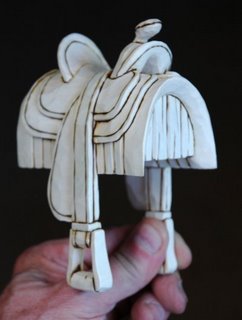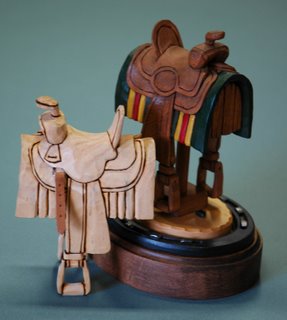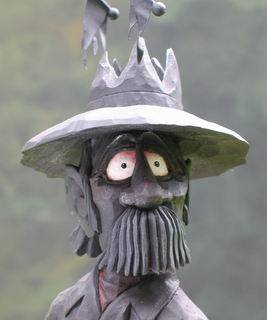
I have attached a number of photos of a carving I did a couple of years ago which, I think, illustrates the importance of adding details to your carvings to carry the theme of just what you're trying to capture. Having strung a barbedwire fence around our property a few years back I can symphathize with the attitude of this Cowpoke. It's not fun! However, it does make a good and amusing subject for a caricature carving.
The first step in creating this piece was the construction of the Post-Hold Diggers. I brought my diggers into the shop and worked up a cardboard pattern of the metal part of the blades. I then cut two blades out of some thin tin and bent them to shape. After whittling down the handles and putting the pieces together the thing worked just like the real one! Neat! The barbedwire was made by wrapping wire around finished spool and then adding barbs to the last foot or so. The hammer...well, it's just a hammer. The fence pliers were made to match the ones I used when putting up my fence. The staples are just bent pieces of wire and the can was made like I made the cup for the Chuckwagon Cook. The label on the can was painted and then applied.
If you could look down from the top you'd see that the hole he is digging goes down almost all the way to the bottom of the lower base. I put all the pieces together before any finish was applied and drilled the hole. I spent a lot of time on the figure to make it match the digger. To do that I carved the arms and hands separate so the hands could be rotated to match the digger. It would have been almost impossible to do it otherwise.
All in all it turned out to be a real 'classic' and was given as a Christmas Present to a Rancher in West Texas. It was kind of expensive and he kept coming back to look at it over and over during the three days we were at a show in Amarillo. About ten minutes before the show closed he came back one more time and I was sure he was going to carry it off. He didn't! However, about 5 minutes later his wife showed up and made the purchase. She later told me that on Christmas day he about passed out when he opened the box. He said it was the best gift he'd ever received. It's events like that that make carving worthwhile. Not for the money received but for the reward of something you created being really appreciated




